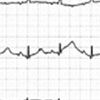- Clinical Technology
- Adult Immunization
- Hepatology
- Pediatric Immunization
- Screening
- Psychiatry
- Allergy
- Women's Health
- Cardiology
- Pediatrics
- Dermatology
- Endocrinology
- Pain Management
- Gastroenterology
- Infectious Disease
- Obesity Medicine
- Rheumatology
- Nephrology
- Neurology
- Pulmonology
Apical Ballooning Syndrome
After a family argument, an 83-year-old woman experienced chest pain, a "racing heart," and a choking sensation and was brought to the emergency department. The chest pain lasted 10 to 15 minutes; was sharp, substernal, and nonradiating; and was associated with dyspnea and a bout of emesis. A sublingual nitroglycerin tablet partially alleviated the pain, but the patient felt syncopal. Her symptoms persisted despite the administration of supplemental oxygen and a second sublingual nitroglycerin tablet. The patient had a history of gastroesophageal reflux disease, allergic rhinitis, and osteoarthritis. Her oral medications included esomeprazole (40 mg/d), aspirin (81 mg/d), and fluticasone nasal spray. She had discontinued valdecoxib 3 weeks earlier.

Click to Enlarge

Click to Enlarge

Click to Enlarge
After a family argument, an 83-year-old woman experienced chest pain, a "racing heart," and a choking sensation and was brought to the emergency department. The chest pain lasted 10 to 15 minutes; was sharp, substernal, and nonradiating; and was associated with dyspnea and a bout of emesis. A sublingual nitroglycerin tablet partially alleviated the pain, but the patient felt syncopal. Her symptoms persisted despite the administration of supplemental oxygen and a second sublingual nitroglycerin tablet. The patient had a history of gastroesophageal reflux disease, allergic rhinitis, and osteoarthritis. Her oral medications included esomeprazole (40 mg/d), aspirin (81 mg/d), and fluticasone nasal spray. She had discontinued valdecoxib 3 weeks earlier. She denied exertional dyspnea, congestive heart failure, hypertension, diabetes mellitus, atrial fibrillation, prior myocardial infarction, and autonomic dysfunction.
At the hospital, the patient was afebrile, alert, and in no distress. Respiration rate was 16 breaths per minute; blood pressure, 106/71 mm Hg; and heart rate, 100 beats per minute. There was no evidence of dehydration, jugular venous distention, edema, or abnormal pulmonary findings. Tachycardic rhythm was regular without gallops or murmurs. Abdomen was benign.
An initial ECG revealed subtle ST-segment elevation in leads V3 through V6 (A). The T waves in these leads appeared hyperacute. Serial serum troponin T levels obtained 8 hours apart progressed from an initial value of 0.03 ng/mL (reference value, 0.1 ng/mL or less) to 1.24 ng/mL and 0.87 ng/mL. The hemoglobin level was 11.9 g/dL (normal, 12.0 to 15.5 g/dL); white blood cell count was 8900/µL (normal, 3500 to 10,500/µL); and platelet count was 322,000/µL (normal, 150,000 to 450,000/µL). Results of a blood chemical analysis were within normal limits. Chest radiography showed clear lungs and normal heart size.
A regimen for treatment of acute coronary syndrome was started, including enoxaparin, a β-blocker, aspirin, a statin, and an angiotensin-converting enzyme (ACE) inhibitor. Cardiac catheterization revealed only minimal luminal irregularities in a right dominant coronary system. An echocardiogram showed normal left ventricular size and mass index with isolated apical dyskinesis (arrows) and an ejection fraction of 40% (B). The findings were consistent with apical ballooning syndrome.
Transient left ventricular apical ballooning (also known as ampulla or takotsubo cardiomyopathy) is a syndrome that involves reversible left ventricular apical and mid-ventricular wall motion abnormalities.1 The syndrome is often confused with myocardial infarction because both may present with acute onset of chest pain, ECG changes (ST elevation or T-wave inversion), and elevation of cardiac enzymes. However, affected patients have no evidence of coronary artery disease on catheterization, and echocardiography shows dyskinesis ("ballooning") of the ventricular apex or mid ventricle. Left ventricular function can be severely impaired but typically returns to normal within days to weeks.2-4
The syndrome is most common in postmenopausal women and is almost always precipitated by sudden physical or emotional stress. It is estimated to occur in 1% to 2% of all suspected myocardial infarctions.3 The pathophysiology is unclear, but data suggest the syndrome may be caused by catecholamine-induced microvascular spasm, because of seemingly supraphysiological levels of plasma catecholamines in affected patients.5
Treatment is supportive. Anticoagulation is also indicated to prevent intramural thrombus formation until cardiac function has been restored.2 Complications (most commonly pulmonary edema during the acute presentation) are rare. The prognosis is excellent, and the recurrence rate is low.2,3
This patient remained asymptomatic during the remainder of her hospitalization. Dosages of the ACE inhibitor and β-blocker were limited because of hypotension, and the ACE inhibitor was ultimately withdrawn. A second ECG on hospital day 2 showed normal sinus rhythm with resolution of the ST-segment elevation. After 48 hours, she was discharged with a regimen of metoprolol succinate, sublingual nitroglycerin, and simvastatin. Seven days after discharge, echocardiographic studies continued to show abnormal left ventricular systolic function with an ejection fraction of 41% and grade 1 diastolic dysfunction. A follow-up echocardiogram 3 weeks later showed resolution of the apical wall motion abnormality (arrows) and an ejection fraction of 76% (C).
References:
REFERENCES:
1.
Sato H, Tateishi H, Uchida T, et al. Tako-tsubo-like left ventricular dysfunction due to multivessel coronary spasm. In: Kodama K, Haze K, Hori M, eds. Clinical Aspect of Myocardial Injury: From Ischemia to Heart Failure [in Japanese]. Tokyo: Kagakuhyoronsha Publishing Co; 1990:56-64.
2.
Bybee KA, Kara T, Prasad A, et al. Systematic review: transient left ventricular apical ballooning: a syndrome that mimics ST-segment elevation myocardial infarction. Ann Intern Med. 2004;141:858-865.
3.
Akashi Y. Reversible ventricular dysfunction takotsubo (ampulla-shaped) cardiomyopathy. Intern Med. 2005;44:175-176.
4.
Korlakunta HL, Thambidorai SK, Denney SD, Khan IA. Transient left ventricular apical ballooning: a novel heart syndrome. Int J Cardiol. 2005;102:351-353.
5.
Wittstein IS, Thiemann DR, Lima JA, et al. Neurohumoral features of myocardial stunning due to sudden emotional stress. N Engl J Med. 2005;352:539-548.
